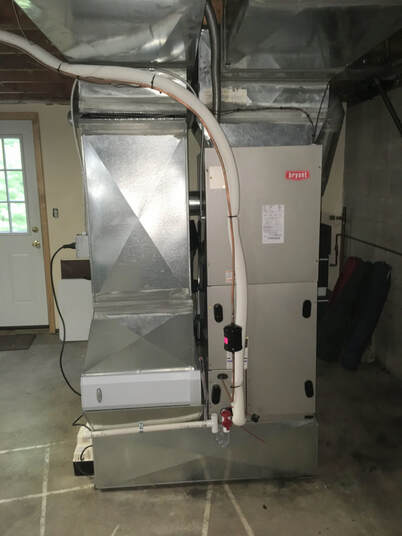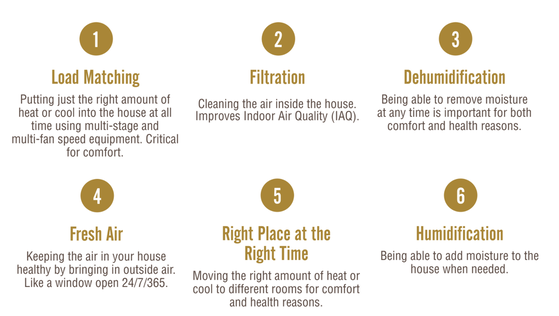|
BAD ASS HVAC turned out to be a larger topic than I first thought! In the first 4 parts we talked about the theoretical side of what every HVAC system should be able to do but most can’t. I’ll summarize and link to those parts later. In this part we will dig into the practical side, what the system actually looks like. We’ll start with the BAD, or Big Ass Drop. The “return drop” is the duct that connects the cold air returns of a home’s HVAC system to its furnace, air conditioner, and/or heat pump. Big Ass Drop was a nickname coined by Michael Housh of Housh Energy Experts in Monroe, Ohio. I had posted a picture like this one in a Facebook group, and Michael commented “that’s a Big Ass Drop!” The name stuck. All over Facebook HVAC groups putting a big filter in an oversized “return drop” became known as a Big Ass Drop. From there it was a short hop to BAD ASS HVAC, which describes the systems we’ve been installing since 2014 that tackle all 6 Functions of Good HVAC: Done right, a Big Ass Drop facilitates 3 of the 6 functions of HVAC - filtration, fresh air, and mixing. For the other functions we have other tools which we’ll discuss in the rest of the series. Links To Prior Articles: Part 1 tackled load matching and filtration. Part 2 looked at dehumidification and how it’s the lynch pin to healthy homes in many climates. Part 3 dug into fresh air and how we may not need as much as the standards suggest, which allows for the simpler system we’ll be discussing this time. Part 4 tackled Mixing (right place at the right time) and humidification. Health - The Main Benefit of The Big Ass Drop One main reason for using a Big Ass Drop is reducing health risks. We breathe about 3000 gallons of air per day, at least 2700 of them indoors, and most of those 2700 inside our homes. This is something most of us can have direct control over. As we covered in part 1, the fine particles that get into our lungs and blood can have substantial health effects. Collectively, particulate matter will take about 2 years off each one of our lives. Two examples of this are diesel soot, which contains a lot of heavy metals in very small particles, and viruses, which often travel inside small spit droplets. By reducing how much garbage our bodies have to filter out, good filtration helps improve our respiratory health and make us more resilient to infections, allergies, and asthma. If you want to learn more, here’s a list of air quality researchers I follow on Twitter. Client Feedback - Some Things Installing a BAD Improved In Their Lives
What Does a BAD Look Like? First, let’s look at what a typical return drop looks like, this is what the system at the beginning of the article looked like before we changed it: Note how the return drop is pretty small, it’s only 8” wide instead of the 20-30” of a BAD. The filter in this unit is on the bottom of the furnace after two hard turns. Air at these pressures acts just like water, so we’re asking it to make two hard turns in a very short time, then try to go through a restrictive filter. This leads to high pressures inside the system and a fan that has to work hard to move air. Older systems with old school PSC blower motors did this without burning out, but newer ECM motors, required after July of 2019 in new furnaces, use a lot of energy and fail prematurely when run under lot of pressure. They are also pretty expensive to replace. The ideal system looks like this drawing that Michael Housh did: Note that instead of that tiny return drop duct, the return is the same size as the filter. The filter is mounted horizontally, so return air flows evenly across the whole filter.. The whole surface loads up with dirt pretty evenly so it will filter more dirt before needing to be changed.
A radius or turning vane as it turns to go into the system is a nice touch and advisable if you have space constraints. But they do not seem to be necessary if the drop is large enough (which surprised us!) We’re also seeing that these media filters are creating very little backpressure in the system, often as low as 0.05” water column. They are rated for 0.1” for the most part, but if you measure they usually come in around twice that in typical installations. Because of the horizontal installation, the air hits the filter in laminar, not turbulent flow, which also helps with pressure. A Breath of Fresh Air Tracking is better than guessing, and it’s hard to manage what you don’t measure. We track indoor air quality on many of our client homes, and always recommend that people have indoor air quality monitors. Note the duct coming out a bit above the filter. That’s a return duct going off to the outdoors to bring in fresh air. In part 3 we talked about how in our air quality monitoring, it looks like many homes don’t need the full recommended ASHRAE 62.2 airflow rate (that’s the industry standard for residential fresh air.) We may be ok with only half that. That’s important because this “return scuttle” typically provides 30-50 cfm on high fan speed on our projects, which is usually about half of 62.2. That fresh air comes “free” because it uses the air handler fan, which also gets us that mixing and filtration. Low Pressure = Bang for Buck The low pressure from a BAD helps lead to very low energy use on the air handler fan (that’s the furnace or heat pump fan). We find our systems use between 15-40 watts on low fan speed, which is about $1-6/month of electricity running 24/7, depending on your electricity rates. For that $1-6/month you get: mixing to blunt temperature differences, mixing to even out carbon dioxide levels, excellent filtration to clean the air, and, oh yeah, fresh air! That’s pretty cheap for what could be a substantial bump in respiratory health. To repeat, most of the 3000 gallons of day we breathe is fromare inside our homes, so this is a lot of bang for the buck. Fresh Air Basics We should pause for a moment to lay out the 3 basic strategies for bringing in outside air (which often isn’t fresh, by the way.) The strategies have multiple names, so I’m lumping the names together to reduce confusion.
Buying Budget for BAD ASS HVAC by Deleting Dedicated Fresh Air Systems One of the nice things about using the air handler for fresh air is that we can delete a $2-3K ERV or HRV (energy or heat recovery ventilator), or a $3-5K ventilating dehumidifier from an HVAC budget. That budget can then be aimed back at the central HVAC system. The cost difference between a low end furnace and AC and a medium to high end heat pump or hybrid system is about $2-7K. That’s about what we just saved by deleting the dedicated fresh air system. Currently 85% of new residential HVAC is oversized and single stage, which makes doing a BAD ASS system not only difficult, but impossible in most cases. By changing fresh air strategies, we may be able to buy back the budget to shift the industry to installing more multiple stage HVAC. I realize this is controversial, but if we want to see healthier, more comfortable homes become the norm and not the exception, we need to find a way to get there, and this is one path. Pros and Cons of BAD ASS Fresh Air Where ERVs and HRVs can fail without anyone knowing, with BAD ASS HVAC you know the fresh air isn’t coming in because the heating or cooling of the house is broken. We like to put a temperature controlled damper on the fresh air duct that closes at high and low temperatures. This helps reduce adding extra heating and cooling load during extreme conditions, but isn’t strictly necessary. This will vary with your climate and preferences. While that means that a few days a year a house isn’t getting purposeful fresh air, in those conditions stack effect (see the Comfort 101 chapter of The Home Comfort Book) helps take over in all but the tightest homes. So far in watching our air quality monitors, the effect isn’t strong. The big con of supply only fresh air in the BAD ASS HVAC system is really low flow rate. This could be solved with a larger duct to outdoors, a second duct to outdoors, or a dedicated fresh air unit like an ERV, HRV, or ventilating dehumidifier. The other con comes from the pressurization tactic. If you live in a cold climate and you run high humidity levels, that does carry risk of rotting out wood in your home. If you use a humidifier, aim to keep those levels in the 30-40% relative humidity range to help reduce this risk. It may need to be lower still as the temperature drops below 20F. Most good thermostats can do that automatically. We also recommend “water saver” humidifiers that use about ⅔ less water than standard models. If it takes more than that to keep your indoor humidity levels comfortable, you probably need to air seal the house. BAD Synergies The Big Ass Drop comes with some nice synergies. By increasing the size of the return drop, it usually makes a huge difference in the Total External Static Pressure of the system (that’s basically HVAC blood pressure, and should be between 0.08-0.5” water column.) In our retrofits we’ve seen between 0.15” and 0.4” at high fan speed. These systems often start well over recommended levels, typically 0.8-1.2”. Those low pressures allow for very inexpensive filtration, fresh air, and mixing. They also help keep your system clean inside and will likely help it last longer. These systems tend to be very quiet too, one of my favorite things to do at the end of a project is turning the system up to 100% and asking the lady of the house if the noise is bothersome. The answer is usually, “Is it on? I can’t hear it.” Installing a BAD takes a little extra time and money, but they do offer a lot of bang for the buck in our experience, and should be offered at equipment replacement time. A BAD Doesn’t Fix Everything Of the 6 Functions of HVAC, a BAD can help with filtration, mixing, and fresh air, but that still leaves load matching, dehumidification, and humidification. How do we get those other three done? You’ll have to come back next time to find out!See you next time when we discuss BAD ASS HVAC! |
AuthorNate Adams is fiercely determined to get feedback on every project to learn more about what works and what doesn't. This blog shows that learning process. |
ServicesCompany |
Buy The Home Comfort Book!
© COPYRIGHT 2017. ALL RIGHTS RESERVED.
|
 RSS Feed
RSS Feed





